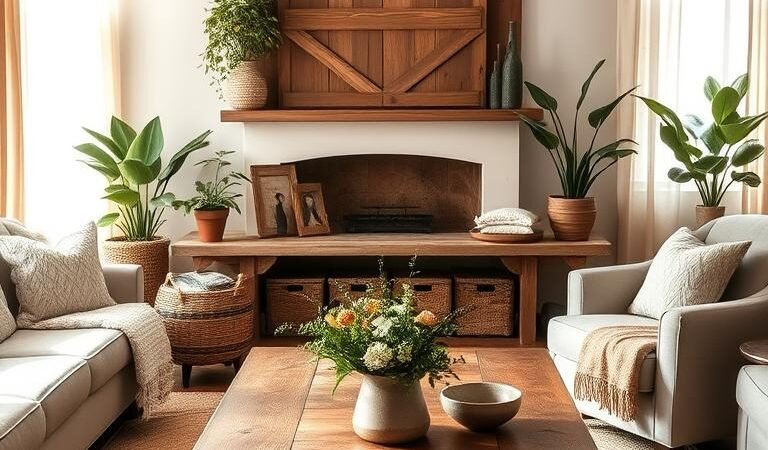Earthy hues and organic textures create spaces that feel both comforting and elegant. This design approach blends soft neutrals with raw materials, offering a perfect balance of simplicity and depth. The result? Rooms that invite relaxation while maintaining a polished look.
Modern farmhouse and rustic interiors often embrace this philosophy. Layered fabrics, subtle grain patterns, and muted palettes work together to craft a welcoming atmosphere. Every detail, from furniture choices to lighting, contributes to the overall harmony.
For those seeking inspiration, this guide explores how to achieve warmth without sacrificing sophistication. Discover the art of mixing textures, selecting the right wood finishes, and curating a space that feels effortlessly inviting. Learn more about blending rustic charm with contemporary touches in our modern farmhouse decor guide.
Key Takeaways
- Earthy tones and natural materials create inviting spaces.
- Neutral palettes enhance a room’s calming effect.
- Layered textures add depth and visual interest.
- Lighting plays a key role in setting the mood.
- Mixing rustic and modern elements achieves balance.
Introduction to * Country Classic: Warm Neutrals and Natural Wood Accents
A home should reflect the soul of its inhabitants—soft neutrals and raw textures achieve just that. This interior design style blends rustic charm with refined simplicity, creating spaces that feel lived-in yet polished. Think weathered oak tables paired with linen upholstery, where every piece tells a story.
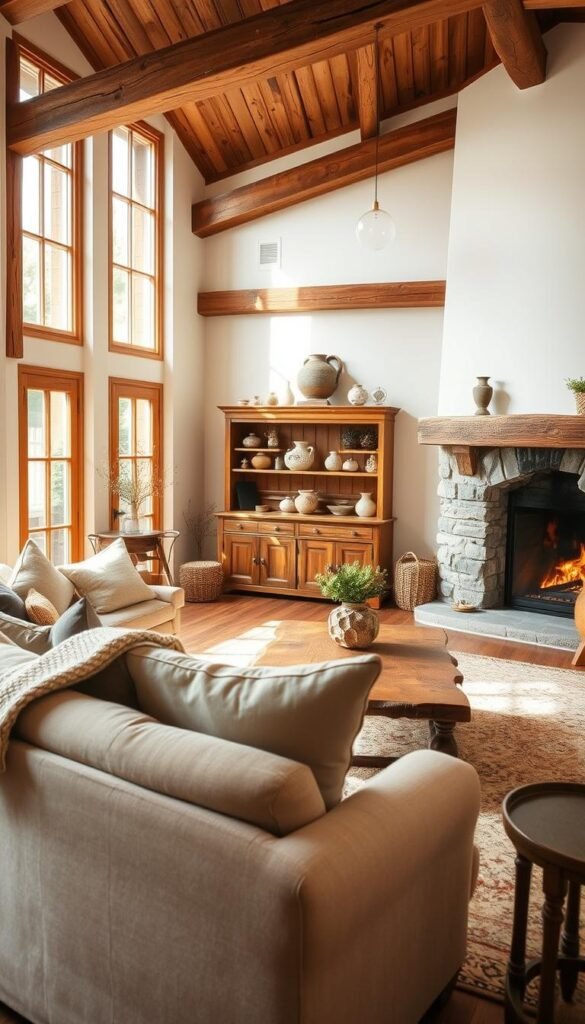
Livability is central to the philosophy. Organic materials like stone, jute, and unfinished wood add tactile warmth, while muted tones—think creamy beiges and smoky taupes—evoke a sense of calm. These elements work together to craft rooms that soothe rather than overwhelm.
Psychologically, warm neutrals reduce stress by mimicking natural landscapes. A 2022 study found that spaces with earthy palettes lowered cortisol levels by 17%. The subtle variations in wood grain further enhance this effect, offering visual interest without chaos.
| Color | Psychological Impact | Best Use |
|---|---|---|
| Beige | Promotes relaxation | Living rooms, bedrooms |
| Taupe | Encourages focus | Home offices |
| Oatmeal | Enhances comfort | Dining areas |
Designer Beril champions this approach, calling homes “extensions of personality.” Her projects often feature hand-carved shelves or repurposed barn doors—details that whisper individuality. It’s not just aesthetics; it’s about crafting spaces that resonate deeply.
Quiet luxury emerges in the details: a walnut coffee table’s whorls, the irregular weave of a wool throw. Here, beauty lies in imperfection, inviting you to slow down and savor the everyday.
Why Warm Neutrals and Natural Wood Accents Work Well Together
The magic happens when soft neutrals meet raw wood textures—creating harmony in every corner. These color pairings evoke a sunlit warmth, making rooms feel inviting yet refined. Designers often lean toward this combo for its versatility across design styles, from coastal to rustic.
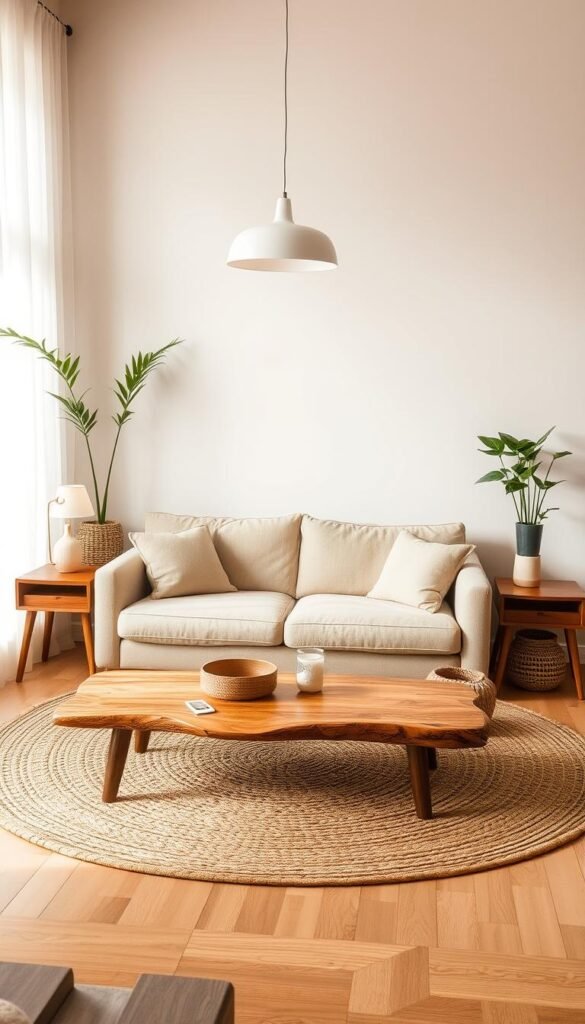
Neutrals works well as a backdrop, letting wood grains become the star. Warm grays or beiges highlight the organic swirls in oak or walnut, adding depth without clutter. This balance is key in smaller space, where light reflection makes walls recede visually.
Natural wood brings tactile contrast to smooth, muted walls. Think of a reclaimed barn door against Cobblestone gray paint—a pairing Country Chic Paint perfected. The wood’s roughness plays against the paint’s softness, creating layered interest.
In coastal farmhouse spaces, whitewashed oak and linen upholstery mirror sandy shores. Modern rustic interiors might pair charcoal-stained cedar with creamy leather. Each example proves how neutrals ground the rawness of wood, crafting rooms that feel both airy and anchored.
The Perfect Color Scheme for a * Country Classic Look
Balancing light and dark tones transforms a room into a sanctuary of calm sophistication. A well-curated color scheme blends earthy hues with subtle contrasts, enhancing the organic appeal of raw materials. This approach creates layers of visual interest while maintaining cohesion.
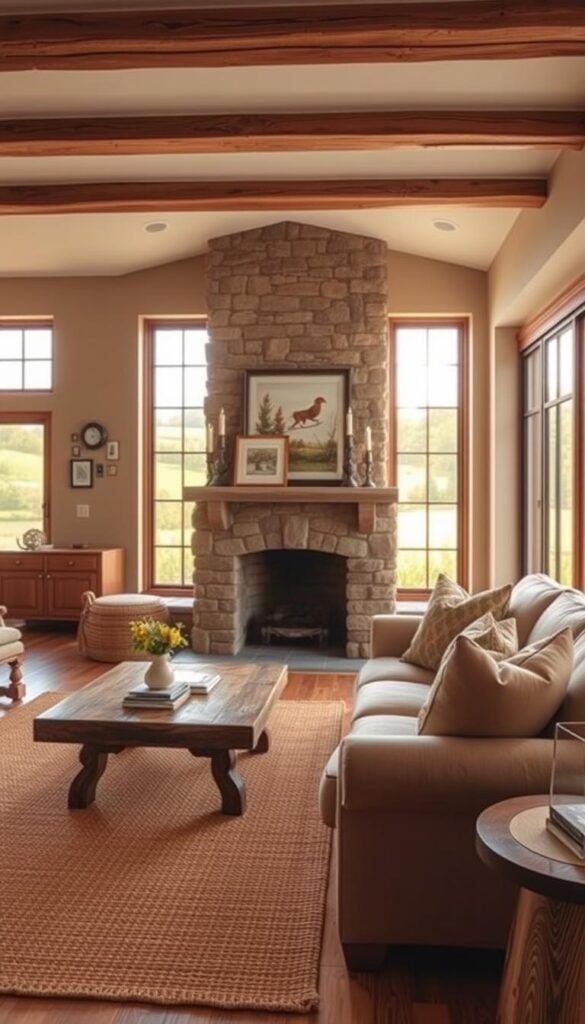
Light vs. Dark Tones: Finding the Right Balance
Light tones, like Lazy Linen, reflect sunlight and amplify space—ideal for small rooms. Darker shades, such as Liquorice, anchor large areas with dramatic depth. The key lies in proportion: 70% light to 30% dark avoids overwhelming the eye.
Mid-tone Hurricane gray bridges the gap. Paired with oak, it adds sophistication without stark contrast. Designer Maria Vittoria recommends this for open-concept homes where flow matters.
Neutral Colors That Add Depth and Warmth
Follow the 60-30-10 rule for layering:
- 60% dominant shade: Pebble Beach gray (walls, large furniture).
- 30% secondary tone: Sunday Tea greige (upholstery, curtains).
- 10% accent: Crinoline white (trim, decor)—its pink undertones soften wood-heavy spaces.
| Color | Effect | Pairing |
|---|---|---|
| Pebble Beach gray | Versatile base | Reclaimed pine |
| Sunday Tea greige | Calming | Walnut finishes |
| Crinoline white | Softens | Rustic beams |
For cohesion, repeat one neutral across floors, walls, and textiles. This ties the space together while letting wood grains shine.
Choosing the Right Natural Wood for Your Home
Selecting the ideal wood species transforms a neutral palette into a layered, inviting space. Each grain pattern and stain interacts uniquely with light and surrounding colors, creating distinct moods. From white oak’s subtle elegance to walnut’s rich depth, your choices shape the interior’s character.
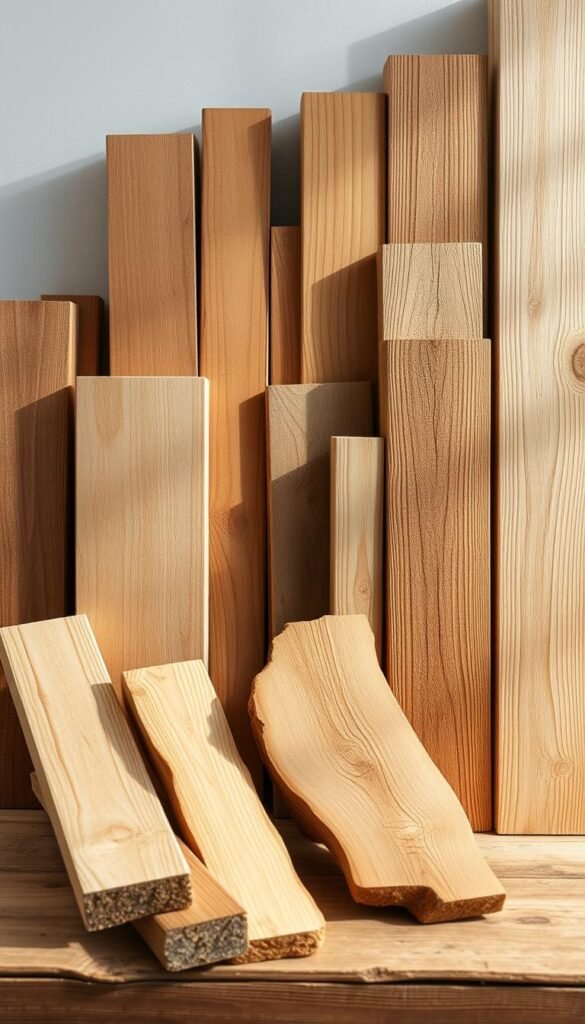
Types of Wood That Complement Warm Neutrals
Light woods like ash or maple brighten rooms with Cheesecake cream walls, enhancing airiness. Mid-tone options—cherry or caramel-stained oak—pair beautifully with gray, as seen in mid-century spaces. Dark walnut adds drama to muted schemes without overwhelming.
Consider these popular pairings:
| Wood Type | Best With | Effect |
|---|---|---|
| White oak | Oatmeal walls | Modern simplicity |
| Reclaimed pine | Smoky taupe | Rustic charm |
| Walnut | Pebble gray | Luxurious contrast |
How to Mix Different Wood Tones
Follow the three-tone rule: one dominant (floors), one secondary (furniture), and one accent (decor). For cohesion, ensure all woods share undertones—cool or warm. Designer Beril suggests testing combinations with floating shelves before committing.
Key techniques:
- Unify with paint: Cheesecake cream walls bridge varied wood finishes.
- Repeat textures: Use similar grain patterns in different stains.
- Layer neutrals: Jute rugs or linen drapes soften contrasts.
Furniture Selection for a * Country Classic Space
Thoughtful furniture choices define the soul of a room—each piece contributes to its character. In this style, every item should balance rustic charm with refined simplicity. The goal? A space that feels collected over time, not overly staged.
Key Pieces to Anchor Your Design
Start with foundational items that exude warmth. A farmhouse table with turned legs becomes a natural gathering spot. Pair it with Windsor chairs for a touch of heritage. Linen-upholstered sofas in Vanilla Frosting soften the look, letting carved wood details shine.
For walls, Simplicity white creates a cohesive backdrop. This shade enhances grain patterns without competing for attention. Floating shelves in reclaimed oak add texture while keeping the space airy.
Mixing Vintage and Modern Furniture
Blend eras for dynamic contrast. Try an industrial metal console with a live-edge wood top. Paint vintage dressers in Hurricane gray to modernize their silhouette. The mix adds depth while maintaining harmony.
Smart storage solutions preserve the aesthetic:
- Woven baskets hide clutter with organic texture
- Open shelving displays pottery or aged books
- Repurposed crates as side tables add rustic elements
Remember: scale matters. Oversized pieces can overwhelm neutral palettes. Opt for proportional furnishings that let the design breathe.
Adding Texture to Enhance Your Design
Texture transforms rooms from flat to fascinating—layering depth where it matters most. Tactile contrasts invite touch and create visual interest, turning neutral spaces into dynamic retreats. The key? Balancing soft and rough, matte and glossy, for a room that feels curated, not chaotic.
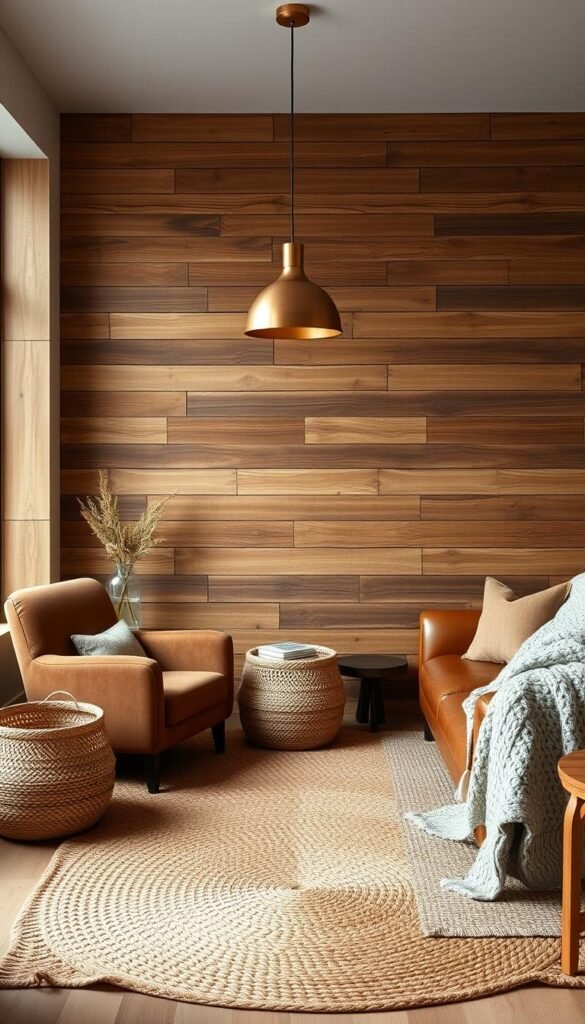
Textiles That Bring Comfort and Style
Fabric choices add instant warmth. Layer nubby wool throws over sleek linen sofas for a cozy yet polished look. Mustard ochre pillows pop against gray bedding, as seen in Source 3’s studies. Designer Beril’s velvet pillow hack elevates neutral schemes with luxe contrast.
Consider these pairings:
- Chunky knits with smooth leather chairs
- Bouclé ottomans against rustic wood floors
- Sheer linen curtains filtering light onto rough stone walls
Stone and Metal Accents for Contrast
Hard materials ground soft textiles. Travertine coasters on a walnut table add organic texture. Hammered copper pendants above a live-edge breakfast bar create rustic-modern tension. For drama, try a stone veneer accent wall with Pebble Beach gray trim.
| Material | Pairing | Effect |
|---|---|---|
| Brushed brass | White oak shelves | Subtle sheen |
| Slate tiles | Jute rugs | Earthiness |
| Wrought iron | Linen drapes | Industrial softness |
Pro tip: Limit metal finishes to two per room for cohesion. Mixing black iron with brass keeps the palette intentional.
Lighting Ideas to Complement Warm Neutrals
Lighting shapes the mood of a room—choosing the right fixtures enhances both function and beauty. In spaces with warm neutrals, illumination highlights textures and adds depth. The interplay of shadows and glow creates a layered, inviting design.
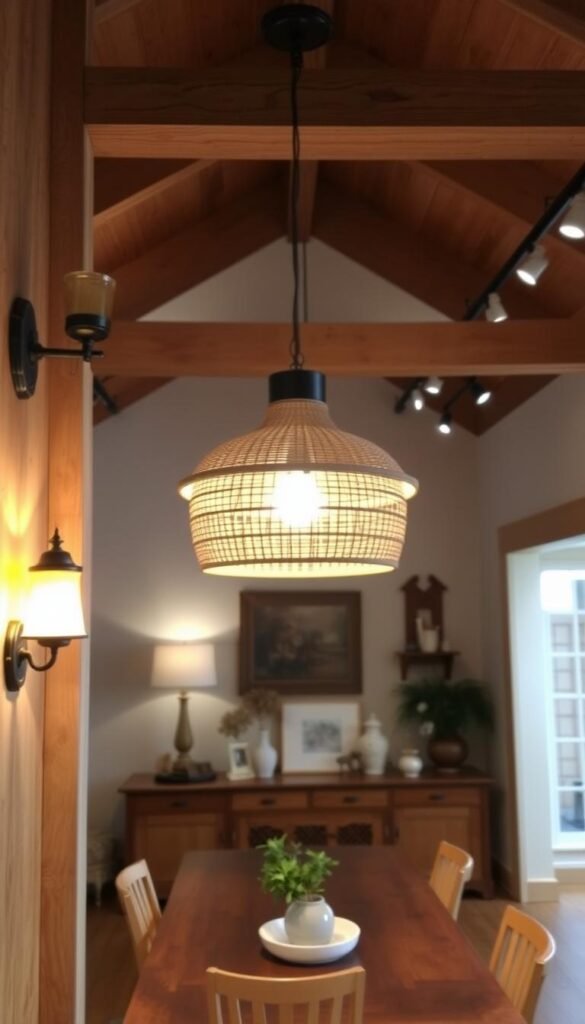
Choosing Fixtures That Enhance Wood Accents
Aged brass sconces cast a golden glow on wood paneling, amplifying its warmth. For a dramatic touch, Liquorice black chandeliers contrast beautifully with light oak beams. Position LED strips inside open shelves to showcase grain patterns subtly.
Consider these pairings:
- Matte black pendants over a reclaimed dining table
- Wrought iron lanterns beside linen-upholstered seating
- Brushed nickel floor lamps near walnut sideboards
Natural Light vs. Artificial Light
Sheer linen curtains diffuse sunlight, softening neutral walls without blocking warmth. In evenings, layer ambient and task lighting:
- Warm bulbs (2700K) enhance Cobblestone gray walls
- Cool LEDs (4000K) brighten workspaces like kitchens
Balance is key. A mix of overhead and accent lights ensures the space feels cohesive yet dynamic.
Wall Treatments for a Cozy Feel
Walls set the stage for any room—choosing the right treatments creates harmony between structure and style. The right finishes enhance wood accents while adding tactile feel. From velvety matte paints to whispering grain patterns in wallpaper, every detail contributes to the interior’s warmth.
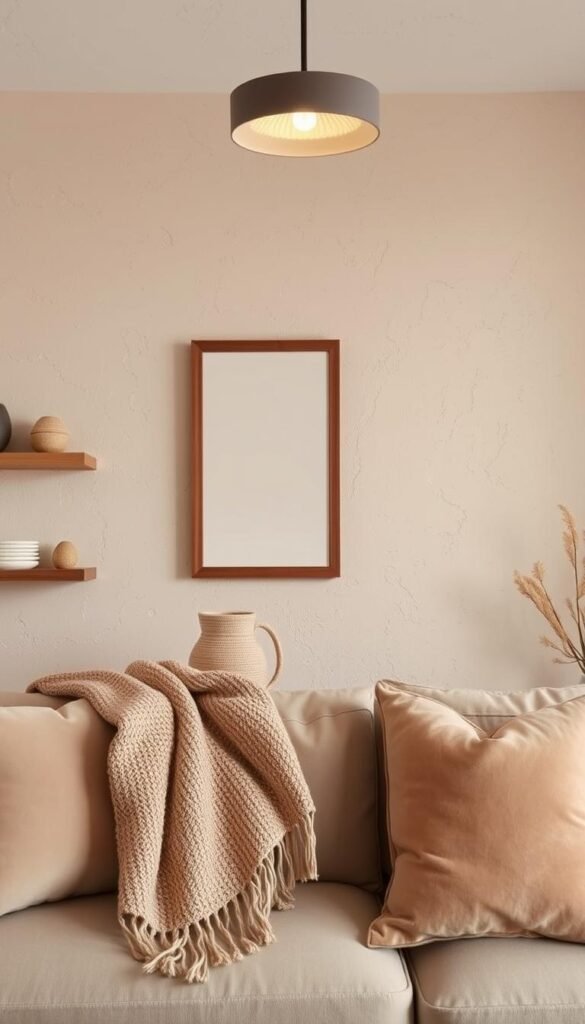
Paint Colors That Pair Well with Wood
Sunday Tea greige builds nostalgic warmth on walls, complementing oak’s golden undertones. Designers recommend flat finishes for contemporary spaces—they absorb light softly. Eggshell bounces light playfully, ideal for highlighting trim details.
For depth, try these techniques:
- Faux finishes: Blend Cheesecake and Hurricane paints for organic variation
- Limewash trends: Adds subtle movement to neutral backdrops
- Board-and-batten wainscoting: Paint lower sections Crinoline white for crisp look
Wallpaper and Other Textured Options
Grasscloth samples mimic nature’s irregularities, pairing beautifully with live-edge shelves. For rustic charm, try:
| Material | Best With |
|---|---|
| Textured vinyl | Modern farmhouse kitchens |
| Flocked designs | Bedroom accent walls |
| Peel-and-stick wood veneer | Rental-friendly updates |
Pro tip: Test small swatches at different times of day. Natural light reveals how textures interact with your wood tones.
Flooring Choices That Elevate the Design
Flooring anchors a room’s aesthetic—selecting the right material sets the tone for every design choice. Hardwoods offer timeless appeal, while layered rugs introduce texture and warmth. Together, they create a foundation that harmonizes with neutral walls and wood accents.
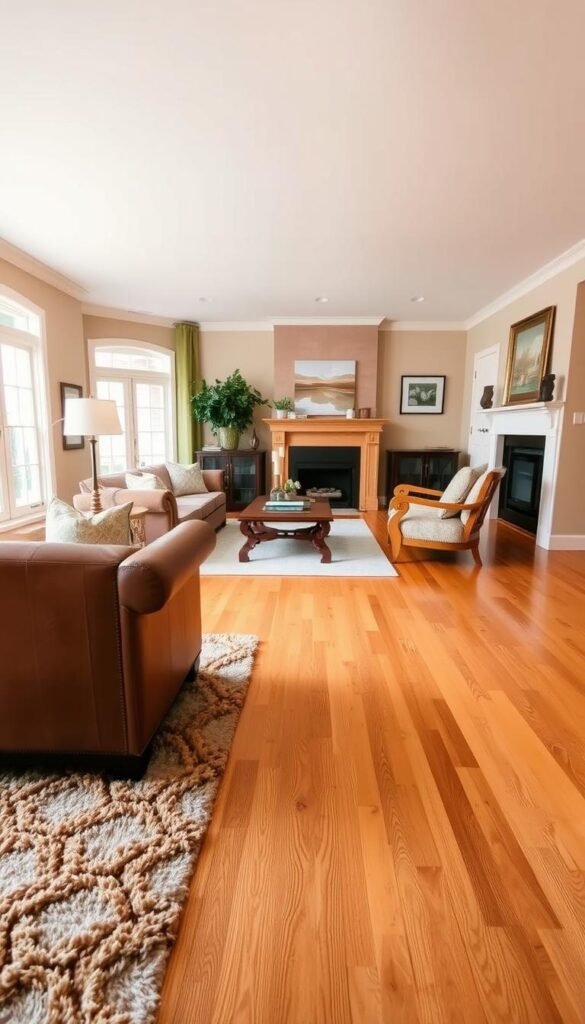
Hardwood Floors: The Ideal Foundation
Wide-plank oak floors exude rustic charm, their broad grains amplifying sunlight in airy space. Herringbone walnut, meanwhile, adds modern sophistication with its geometric precision. Source 3 highlights gray-stained oak as a versatile base for contemporary schemes—cool undertones balance warm neutrals.
For drama, pair Vanilla Frosting walls with ebony-stained floors. The high contrast elevates the room’s depth without overwhelming. Maintain luster with:
- Weekly dust-mopping to prevent scratches
- Beeswax polish for natural shine
- Felt pads under furniture legs
Rugs That Tie the Room Together
Layer a jute base rug with a patterned wool top for tactile contrast. This duo defines seating areas while softening footfalls. Designer Beril sources vintage Persian rugs from Etsy’s OttomanWeaves—their faded hues complement wood tones subtly.
| Rug Type | Best Pairing | Effect |
|---|---|---|
| Jute | Oak floors | Organic texture |
| Wool | Walnut herringbone | Luxurious contrast |
| Vintage Kilim | Gray-stained oak | Bohemian warmth |
Pro tip: Choose rugs 12-18 inches smaller than your seating area to frame the space neatly. This ensures wood borders remain visible, enhancing the room’s layered design.
Creating a Focal Point in Your Room
Every well-designed room needs a magnetic focal point—a visual anchor that draws the eye and sets the tone. Whether it’s a fireplace crowned with heirloom ceramics or a bold mirror reflecting golden hour light, these features infuse spaces with elegance and intention. The trick lies in balancing prominence with harmony.
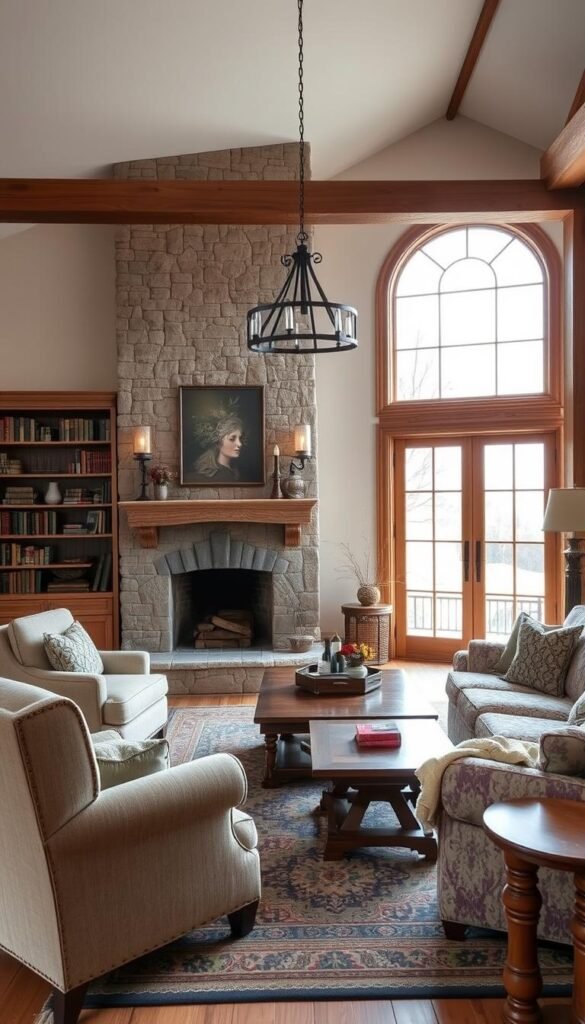
Fireplaces and Mantels as Centerpieces
A limestone fireplace styled with Liquorice-black candlesticks marries rustic warmth with modern edge. The stone’s organic veins contrast sharply against matte metal, creating drama. For reclaimed wood mantels, layer neutral ceramics in varying heights—their earthy textures amplify the accents without competing.
| Element | Pairing | Effect |
|---|---|---|
| Limestone | Brushed iron sconces | Organic-meets-industrial |
| Barnwood | Whitewashed pottery | Softened rustic |
| Slate tile | Copper vessels | Warm contrast |
Art and Mirrors for Visual Interest
Oversized abstract art in Pebble Beach gray tones anchors seating areas with quiet sophistication. For smaller spaces, a gallery wall with wooden frames in walnut, oak, and ash adds depth. Mirrors placed opposite windows amplify light, enhancing the sense of airiness.
- Strategy: Angle round mirrors to catch morning light.
- Texture: Choose frames with hand-carved details.
- Scale:
– Large art for expansive walls
– Cluster small pieces above consoles
These curated moments reflect personality while grounding the room’s design narrative. From mantels to mirrors, intentional focal points turn spaces into stories.
Accessorizing with Warm Neutrals and Wood
Thoughtful accessories breathe life into neutral spaces, adding layers of character. These finishing touches—from hand-carved bowls to patinaed metals—infuse rooms with personality while maintaining cohesive warmth. The secret lies in curating pieces that feel collected rather than matched.
Decor Items That Add Personality
Open shelving becomes a canvas for self-expression when styled with wooden bowls and linen-bound books. Mix heights and materials for visual interest—try stacking Lazy Linen ceramics beside a wrought iron candle holder. This creates rhythm while letting each piece shine.
For a personal touch, update drawer pulls with Liquorice black hardware. The matte finish contrasts beautifully with oak cabinets. Designer Beril’s rule works wonders: “Three natural materials per surface” (like rattan, stone, and wood) prevent clutter while adding depth.
Plants and Greenery for a Fresh Touch
Living elements soften angular spaces effortlessly. An olive tree in a rattan planter brings organic shape to a reading nook. Its silvery leaf texture plays against smooth walls, creating natural contrast.
For tablescapes, driftwood centerpieces paired with neutral ceramics strike the perfect balance. The wood’s weathered grooves tell a story, while simple pottery keeps the look refined.
| Plant | Best Placement | Pairing |
|---|---|---|
| Fiddle-leaf fig | Sunny corners | Jute planters |
| Air plants | Floating shelves | Moss-filled terrariums |
| Eucalyptus stems | Bedside tables | Ceramic vases |
Remember: greenery shouldn’t overwhelm. A single statement plant often makes more impact than multiple small pots. Let each piece—whether a metal decor accent or trailing ivy—have room to breathe.
Designing a * Country Classic Bedroom
A bedroom becomes a retreat when neutral tones and wood textures unite. This style balances restful color palettes with organic materials, crafting spaces that invite deep relaxation. Every element, from bedding to nightstands, contributes to the room’s tranquil sense.
Bedding and Linens in Neutral Tones
Layer Belgian linen sheets in Sunday Tea greige for understated luxury. The fabric’s natural wrinkles add texture while staying crisp against walnut headboards. Mustard ochre throw pillows—like those in Source 1‘s studies—provide subtle contrast against gray duvets.
- Wool area rugs for barefoot comfort on cool mornings
- Drawer liners scented with cedar wood chips for fresh storage
- Textured knit throws at the foot of the bed
Wooden Furniture for a Restful Ambiance
Platform beds with integrated nightstands maximize space without clutter. Choose whitewashed oak for coastal vibes or Hurricane gray stains for modern contrast. The right furniture anchors the room while letting textiles shine.
Designer tips for harmonious pairings:
| Wood Finish | Best With |
|---|---|
| Walnut | Oatmeal walls |
| Reclaimed pine | Smoky taupe bedding |
| White oak | Crisp white linens |
Complete the look with floating shelves for books or ceramics. You’ll love how these elements create a bedroom that feels both curated and comforting.
* Country Classic Kitchen Inspiration
The heart of every home deserves a design that balances function and beauty. This space shines when organic textures meet clean lines, creating harmony between preparation areas and gathering spots. Thoughtful material choices elevate the kitchen from purely utilitarian to genuinely inviting.
Cabinets and Countertops in Natural Wood
Shaker cabinets in Cobblestone gray offer timeless appeal, especially when paired with oak open shelving. The contrast between painted lowers and natural uppers adds visual depth. For counters, honed quartzite mimics stone’s organic variation while resisting stains better than marble.
| Element | Pairing | Effect |
|---|---|---|
| Blue-gray cabinetry | Marble backsplash | Cool elegance |
| White oak shelves | Brass brackets | Warm contrast |
| Walnut islands | Soapstone counters | Organic richness |
Backsplash and Hardware Choices
Zellige tile in Lazy Linen tones creates focal walls with subtle texture variation. For hardware, unlacquered brass develops a lived-in patina over time—perfect for achieving that collected-over-years look. Peg rails add both charm and function, displaying wooden utensils as decorative elements.
Complete the look with:
- Textured curtains to soften window areas
- Open shelving for curated dish displays
- Integrated lighting under cabinets
These elements transform interiors into spaces that feel both fresh and familiar. Every detail contributes to a kitchen that welcomes both culinary creativity and casual conversation.
Living Room Layouts That Embrace Warmth
Furniture placement dictates how a space invites connection and relaxation. The right arrangement makes a room feel like an embrace—think sun-warmed walnut coffee tables within arm’s reach of nubby linen sofas. This isn’t just about aesthetics; it’s crafting zones that naturally draw people together.
Mid-century modern pairings from Source 3 prove gray and caramel tones enhance this effect. The combo creates visual warmth while keeping sightlines clean. Designers suggest leaving 42 inches between seating groups—close enough for conversation, spacious enough for movement.
Arranging Furniture for Comfort and Style
Anchor the design with a focal point, like a fireplace or statement artwork. Flank it with armchairs angled at 45 degrees to foster intimacy. Vintage trunk ottomans pull double duty as coffee tables and hidden storage—perfect for stashing throws when not in use.
Expert tip: Use painter’s tape to map layouts before moving heavy pieces. This prevents strained backs and ensures optimal traffic flow. Cord management systems like discreet cable channels maintain the feel of uncluttered elegance.
Cozy Seating Areas with Wood Accents
Layer sheepskin throws over lounge chairs with walnut frames for tactile contrast. The softness balances the wood’s grain, creating inviting textures. For smaller rooms, try:
- Nesting side tables that tuck away when not needed
- Wall-mounted shelves instead of bulky consoles
- Mirrors to amplify light near darker wood tones
Every choice should whisper “stay awhile.” When seating hugs the walls, the room’s energy dissipates. Pull furniture inward to create intimate islands where connection happens naturally.
Small Spaces: Making the Most of Warm Neutrals
Compact living doesn’t mean sacrificing style—strategic choices can make small spaces feel expansive. Warm neutrals paired with reflective surfaces create an airy design that belies square footage. The key lies in maximizing every inch while maintaining visual flow.
Tips for Maximizing Light and Space
Simplicity white paint bounces sunlight around rooms, making walls seem to recede. Source 1’s studies show this shade can make ceilings appear 6 inches higher. Complement it with:
- Mirrored cabinets in narrow hallways to double perceived depth
- Sheer linen curtains that filter light without blocking it
- Floating shelves in walnut to add warmth without bulk
Paint closet interiors Lazy Linen—the subtle hue creates visual continuity when doors are open. This trick expands sightlines while keeping storage accessible.
Multi-Functional Furniture Ideas
Choose pieces that serve dual purposes without cluttering the home. A console table with flip-down leaves becomes a dining surface for four. Consider these space-savers:
- Nesting tables that tuck under sofa arms when unused
- Murphy beds with integrated nightstands and task lighting
- Ottomans with hidden storage for extra throws
Vertical storage solutions like ladder shelves draw eyes upward, making rooms feel taller. The right furniture arrangement turns limitations into opportunities for clever design.
Conclusion: Bringing It All Together
Crafting a cohesive space begins with balancing simplicity and depth—where every element tells a story. Start with a neutral base, then layer wood textures for warmth. Contrast matte finishes with organic grains to create design harmony. The result? A home that feels both curated and calming.
For those ready to transform their space, Beril’s free Home Renovation Planner simplifies the process. Tackle small projects first: refinish a front door or style a fireplace with reclaimed beams. These updates anchor the sense of timeless style effortlessly.
Remember, great spaces evolve. Let neutrals ground your palette while wood accents add character. With patience and intention, your sanctuary will reflect the quiet luxury of lived-in elegance.
